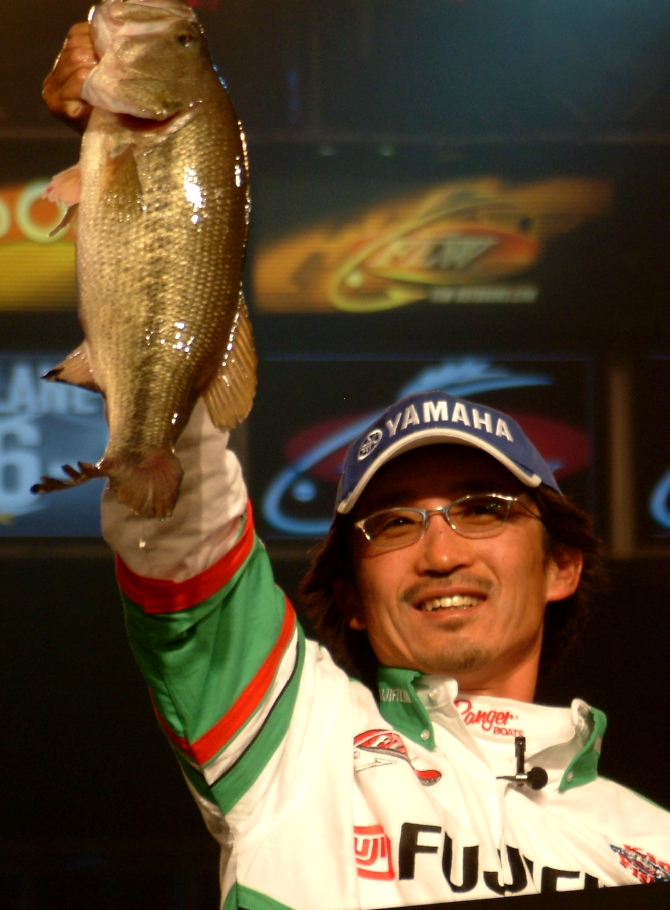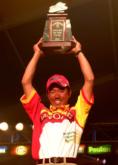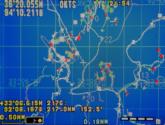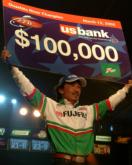East meets West with much success
Japanese anglers’ hard work and scientific approach pay big dividends on FLW Tour

Professional anglers like Guido Hibdon, Rick Clunn and Larry Nixon have long been regarded as natural talents. Like gifted athletes in other sports, their extensive knowledge and expertise in all things bass fishing lends itself to an uncanny ability to read water on the fly and make something out of what appears to be nothing. For the mere mortals in the sport of competitive bass fishing, it’s more about hard work and sometimes a scientific game plan to be successful.
Compound the difficulties of figuring out fish in an ever-changing environment across a multitude of venues with a language barrier that makes finding lakes as difficult as dissecting them, and one begins to understand what it takes to be a Japanese angler at the pinnacle of the sport. There are only a handful of full-time pros from Japan earning a living in competitive bass fishing and most are making a name for themselves through perseverance, a grueling on-the-water practice schedule and an analytical approach to the sport unlike any seen before.
 Takahiro Omori shocked the world when he won the 2004 Bassmaster Classic in dramatic fashion in its waning moments. Shin Fukae surprised a star-studded field when he won the Wal-Mart FLW Tour’s Land O’Lakes Angler of the Year title in 2004 – his very first season as a professional angler in the United States. And Toshinari Namiki put the bass-fishing world on notice that he is an angler to be reckoned with by winning on the Ouachita River during his second top-10 appearance of the 2005 FLW Tour season.
Takahiro Omori shocked the world when he won the 2004 Bassmaster Classic in dramatic fashion in its waning moments. Shin Fukae surprised a star-studded field when he won the Wal-Mart FLW Tour’s Land O’Lakes Angler of the Year title in 2004 – his very first season as a professional angler in the United States. And Toshinari Namiki put the bass-fishing world on notice that he is an angler to be reckoned with by winning on the Ouachita River during his second top-10 appearance of the 2005 FLW Tour season.
 In 2004, Fukae would literally leave one event and head straight to the next event so he could learn the fishery and pattern his fish long before other competitors arrived. He credits his Angler of the Year title to spending so much time practicing. By the time the actual tournaments arrived, he had already experienced almost every weather and water condition that would be encountered.
In 2004, Fukae would literally leave one event and head straight to the next event so he could learn the fishery and pattern his fish long before other competitors arrived. He credits his Angler of the Year title to spending so much time practicing. By the time the actual tournaments arrived, he had already experienced almost every weather and water condition that would be encountered.
Omori had a 40-foot swimming pool built in his back yard with a strip of one-inch tiles down the center. He uses the swimming pool to tune his crankbaits and make sure they run perfectly straight within the tiles for when the bite gets tough and the fish must be finessed into striking – preparation that enabled him to win the Classic.
Most recently Namiki of Hachioji-City near Tokyo joined the top ranks of Japanese anglers – and all bass-fishing professionals – by winning the FLW Tour stop on the Ouachita River in March. The victory is only the second by a Japanese angler in FLW Tour history, and it is only fitting for it to go to Namiki, a former Japan Bass Angler of the Year (1994) and the first Japanese angler ever to qualify for the Bassmaster Classic (1997). Omori was the first Japanese native to win an FLW Tour title when he took top honors on Alabama’s Lake Marin in 2001, and the first Japanese angler to win the Bassmaster Classic.
While so many casual observers consider winning a fishing tournament to be more about luck than skill, it’s often been said that luck is where preparation and opportunity meet. No truer a statement could be made in the case of Namiki’s win on the Ouachita River.
Just a few short days after the Lake Toho event ended in February, Namiki was on his way to Monroe, La., to begin dissecting the fishery and formulating what would ultimately be his winning game plan. After spending a couple of days locking through the south lock of the Ouachita River and probing the famed D’Arbonne Bayou, Namiki decided to investigate Felsenthal on the far side of the north lock. After just a day scouting the area, Namiki returned to Monroe, checked out of his hotel and headed back to Felsenthal to check in to a hotel there.
 Namiki spent the next three weeks mapping the fishery with his Hondex depth finders and GPS units. Because these units don’t have American maps, he literally created a map of Felsenthal by following contours and channels until he had a useable navigation aid for the area. He meandered back over the area while fishing, marking hazards in the sloughs. He also relied heavily on a hunter’s map of the Felsenthal National Wildlife Refuge that he purchased for about $40. “That map helped me a lot,” Namiki said.
Namiki spent the next three weeks mapping the fishery with his Hondex depth finders and GPS units. Because these units don’t have American maps, he literally created a map of Felsenthal by following contours and channels until he had a useable navigation aid for the area. He meandered back over the area while fishing, marking hazards in the sloughs. He also relied heavily on a hunter’s map of the Felsenthal National Wildlife Refuge that he purchased for about $40. “That map helped me a lot,” Namiki said.
As he caught fish during practice, he recorded everything in as much detail as his GPS unit would allow. “If I caught a fish over 3 pounds, I would mark it with a red fish symbol,” Namiki said. “If I caught fish less than 3 pounds, I would just mark it with a green fish symbol.” He also marked rocks, stumps, brush and obstacles in his course, using differing icons and colors until he had a clear picture of where he needed to concentrate his efforts.
From there he had to plan how to get to his fishing areas from the tournament launch site. “Because it’s such a long way there and back, I needed to be sure I had the gas and time to fish and move around and still make it back in time,” Namiki said.
Namiki’s Ranger boat holds about 52 gallons of gas when full, but he found if he elevated the passenger side while fueling, he could get an extra few gallons in the tanks. From there he began scientifically calculating how much gas he would burn running to Felsenthal and back at full speed with two people and all their gear. He even made another plan based on using tour boats the final two days, as they only hold 48 gallons of fuel.
“I probably spent between $1,000 and $1,500 in gas preparing for, and fishing, this tournament.” Namiki said.
Then he set out evaluating water conditions and charting how water levels might play out long before the tournament got under way. “I was watching the online readings for the water levels in Felsenthal every day for about three weeks, so I knew what the water level and current would be during the tournament,” Namiki said. “I knew before the tournament that I would have to find an area where the fish would bite without current.”
 Because the water was dropping in Felsenthal, many anglers reaped the benefits of catching good limits of bass in the current created by the lowering levels. But as the current stopped and the water levels stabilized, Namiki’s areas got stronger while other areas diminished. “I was fishing an area that was a good spawning area out of the current,” he said.
Because the water was dropping in Felsenthal, many anglers reaped the benefits of catching good limits of bass in the current created by the lowering levels. But as the current stopped and the water levels stabilized, Namiki’s areas got stronger while other areas diminished. “I was fishing an area that was a good spawning area out of the current,” he said.
Another key for Namiki was having productive areas to himself. He shared some water with fellow pro Mike Hawkes of Sabinal, Texas, but Hawkes was on a completely different pattern.
“We shared a cut in Shallow Lake the first two days of the tournament, but I never went back in there during the final round,” Hawkes said. “We’d seen each other all through practice and all through the tournament, but we really weren’t fishing that close to each other.”
While lots of anglers can catch fish, very few ever make it to the winner’s circle on instinct and luck alone. Much like the influx of Western anglers who continue to score big wins on Eastern waters, thanks to finesse tactics honed west of the Mississippi, Japanese anglers like Namiki, Fukae and Omori are proving that there is no substitute for dedication and hard work when it comes to winning at bass fishing’s highest levels.
###
Editor’s Note: The March 11, 2005, article appearing on FLWOutdoors.com recounting Toshinari Namiki’s FLW Tour win contained some inaccuracies that have since been corrected.
###